-
 Impact of Hypertension on Covid-19 Mortality Rate: A Systematic Review and Meta-Analysis
Vol 9 No 1 (2022)
Impact of Hypertension on Covid-19 Mortality Rate: A Systematic Review and Meta-Analysis
Vol 9 No 1 (2022)Muhammad Ifham Hanif1, Taufik Ridwan Hadi Kusuma2, Saiful Hidayat2, Naufal Aminur Rahman2
- Fakultas Kedokteran, Universitas Padjadjaran, Bandung
- Fakultas Kedokteran, Universitas Sebelas Maret, Surakarta
Correspondence: muhammadifhamhanif@gmail.com
ABSTRACT
Introduction: As the WHO has declared that Coronavirus Disease 2019 (COVID-19) is a global emergency, clinical predictors of severity must be identified to optimize the treatment. Hypertension is the most prevalent comorbidity. It has been commonly reported that it increases the mortality rate, although some research has shown conflicting results. This study aims to measure some literature on the correlation between hypertension and mortality rate in COVID-19.
Methods: This study is a meta-analysis. The research was conducted using secondary data by searching and selecting clinical studies. The article searching was through a systematic and comprehensive database from PubMed, ScienceDirect, Google Scholar, ProQuest, and Springer Link. Articles were collected using the PRISMA diagram, critically appraised using the PRISMA checklist and PICO analysis, then the data were analyzed using Review Manager 5.4.1 application with Random Effect Model (REM). The analysis results are the effect size, heterogeneity, and the study model.
Results: Based on the meta-analysis from the five included studies, the hypertension group had a 2.76-fold higher risk of mortality (RR 2.76, 95% CI 2.58-2.96) caused by COVID-19 compared to the group without hypertension. I2 statistics showed heterogeneities among the included studies, and hence the random effect model is used. Funnel plots were plotted for the included studies in the meta-analysis, which suggested a publication bias in the studies of our meta-analysis.
Conclusion: COVID-19 patients with hypertension are associated with a higher risk of COVID-19 mortality rate.
Keywords: Hypertension, COVID-19, Mortality rate.
-
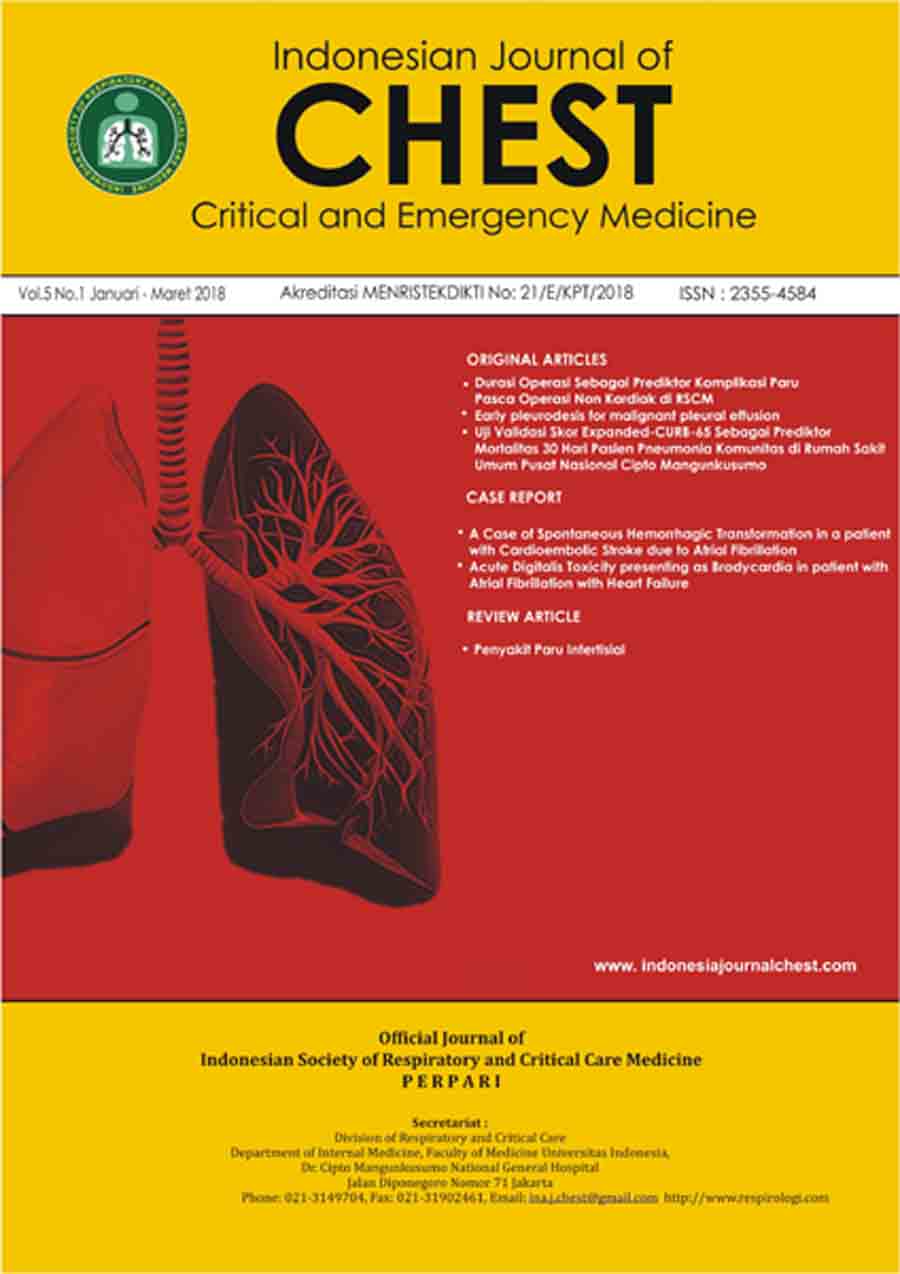 TBC sensitif dan TBC Resistan Obat (TBC RO)
Vol 8 No 2 (2021)
TBC sensitif dan TBC Resistan Obat (TBC RO)
Vol 8 No 2 (2021)Perkembangan di bidang respirologi khususnya di bidang tuberkulosis paru mengalami perubahan yang cukup banyak, terutama dalam pengobatan TBC RO. Program TBC RO yang sering disebut sebagai TB Multi Drug Resistant dimulai pada tahun 2019. Seiring dengan perkembangannya, jumlah kasus TBC RO yang ditemukan semakin meningkat dan tantangan yang dihadapi juga semakin komplek. Pengobatan dimulai dengan regimen standar pada semua pasien dengan menggunakan dasar regimen injeksi Kanamisin/Kapreomisin sesuai dengan rekomendasi WHO. Seiring dengan perkembangan pengobatan MDR, mulai diperkenalkan tahun 2015 obat Bedaquilin oleh WHO sebagai obat baru untuk terapi MDR. Perkembangan selanjutnya, pada tahun 2017, terapi MDR TB dapat diperpendek yang kita sebut sebagai terapi jangka pendek di bawah 1 tahun , tetapi masih memakai regimen suntik. Penelitian terus dilakukan dan diperkenalkan Delamanid sebagai obat untuk regimen jangka panjang pada tahun 2018. Setahun kemudian mulai diperkenalkan regimen all oral longer regimen. Regimen all oral shorter regimen mulai digunakan pada tahun 2020, jadi praktis sejak tahun 2020 semua pasien TB MDR menggunakan regimen tanpa suntikan, kecuali pada kasus-kasus tertentu saja yang menggunakan regimen suntik. Indonesia termasuk negara yang sangat cepat mengadopsi pengobatan TB MDR yang dicanangkan oleh WHO.
-
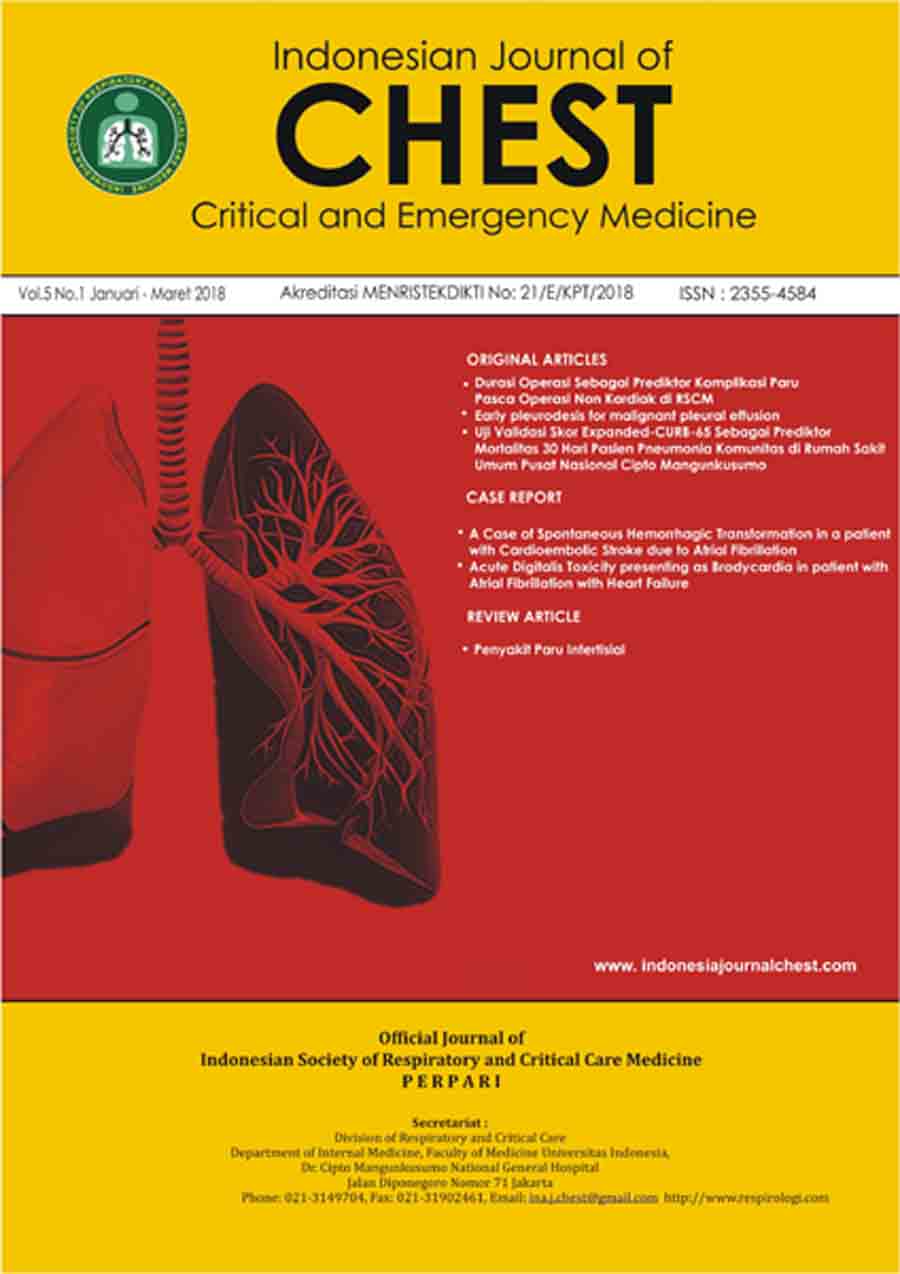 Association Between Fraction And Ratio of CD4_CD8 Bronchoalveolar Lavage Fluid Toward Extuba�tion Status And Mortality Status of Pneumonia Severe Patients
Vol 8 No 2 (2021)
Association Between Fraction And Ratio of CD4_CD8 Bronchoalveolar Lavage Fluid Toward Extuba�tion Status And Mortality Status of Pneumonia Severe Patients
Vol 8 No 2 (2021)ABSTRACT
Background: Extubating failure due to severe pneumonia increases morbidity and mortality. Systemic adaptive immunity, T lymphocyte cells CD4/CD8 in blood, has special role as a mortality predictor in severe pneumonia. Further study still needed to evaluate local adaptive immunity through bronchoalveolar lavage cellular examination in both lungs.
Objective: The aim of this study was to find out the differences between T lymphocytes CD4/CD8 in both lungs based on extubating status and mortality status.
Methods: We performed a cohort prospective study of 40 patients with severe pneumonia whom underwent endotracheal intubation and bronchoscopy hospitalized in intensive care unit between November 2020 to January 2021 in Dr. Cipto Mangunkusumo National General Hospital. Primary data was taken and analyzed using univariate and bivariate to investigate mean or median differences with unpaired t-test for normal numeric distribution data and Mann-Whitney test for abnormal distribution numeric data.
Result: The proportion of extubating failure was 80% and mortality rate was 75%. There were significantly different results of BALF CD4 T cells lymphocyte fraction in severe pneumonia group of patients based on extubating status (p=0,006) and mortality status (p=0,002). Blood CD4 T cells lymphocyte fraction and blood CD4/CD8 T cells lymphocyte ratio were found significantly higher in the successfully extubating group of patients compared to extubating failure group of patients; and also, significantly higher in survived group of patients compared to mortality group of patients with pneumonia severe.
Conclusion: Fraction of CD4 BALF in severely injured pneumonia lungs group of patients who had successful intubation processes were statistically different compared to the group of patients with unsuccessful extubating. Fraction of CD4 BALF were also found statistically different in the group of patients who were survived compared to the group of patients who were passed away.
Key Words: Local Adaptive Immunity; Subset T Lymphocyte; CD4 cells; CD8 cells; Bronchoalveolar Lavage; Extubating failure; Severe Pneumonia -
 Effectiveness of Vitamin D3 in The Form of Calcifediol as Addition to Standard Therapy in Inpatient COVID-19 Patients
Vol 8 No 2 (2021)
Effectiveness of Vitamin D3 in The Form of Calcifediol as Addition to Standard Therapy in Inpatient COVID-19 Patients
Vol 8 No 2 (2021)ABSTRACT
Background: COVID-19 is caused by the SARS-CoV-2 virus and was declared a pandemic in early 2020. Moderate degree COVID-19 patients are generally hospitalized and receive several treatment regimens. Vitamin D3 is one of the additions to the standard therapy of COVID-19. Calcifediol is a more potent vitamin D3, able to increase serum 25OHD levels rapidly. However, it is not yet known the effectiveness of calcifediol in reducing mortality and worsening of COVID-19. Objective: Figure out the effectiveness of calcifediol and standard therapies in reducing mortality or clinical worsening of COVID-19 hospitalization patients.
M
ethods: The literature search was conducted through five databases: Pubmed, Cochrane, EBSCO, ProQuest, and Scopus. Three literatures that matched clinical questions and eligibility criteria were then critically examined using Oxfords Center for Evidence-Based Medicine (CEBM) and Critical Appraisal Skills Program (CASP) forms.
Result: The three selected studies include one RCT and two cohort studies. All studies used calcifediol at doses of 0.266 mg/capsule and standard therapy according to hospital protocol. All three studies suggest that calcifediol and standard therapy can lower the risk of mortality compared to standard therapy use alone, two studies suggest it can reduce clinical worsening in the form of ICU admission.
Conclusion: Administration of calcifediol in addition to standard therapy of COVID-19 inpatients results in a better decrease in mortality and clinical worsening than standard therapy alone.
Keywords: Calcifediol, COVID-19, standard therapy, hospitalization -
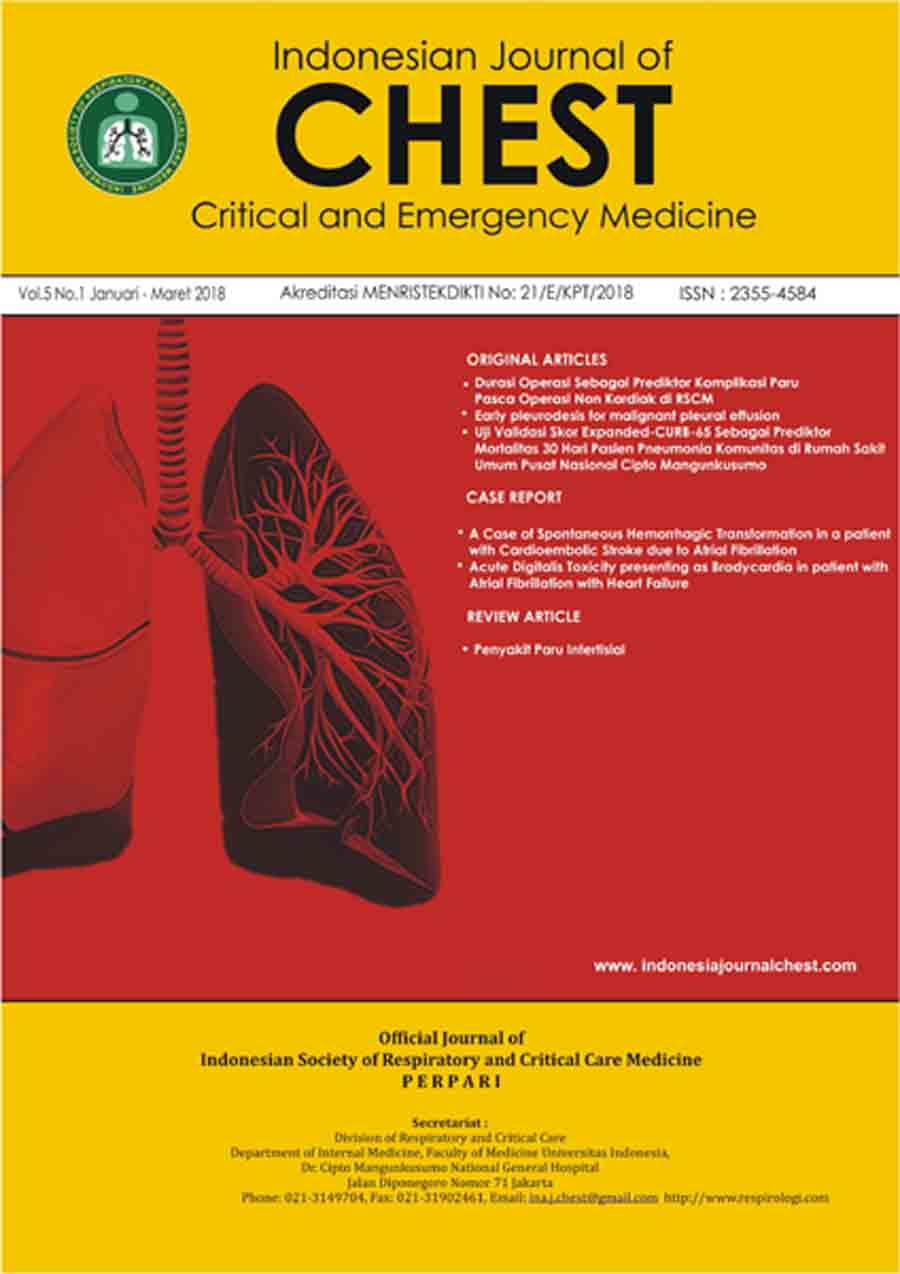 The Role of Rehabilitation Management In Intensive Care Unit Acquired Weakness
Vol 8 No 2 (2021)
The Role of Rehabilitation Management In Intensive Care Unit Acquired Weakness
Vol 8 No 2 (2021)ABSTRACT
Intensive care unit-acquired weakness (ICUAW) is condition of weakness that found in critically ill patient when no reasonable reason besides the presence of critical illness. This condition often occurs in intensive care unit (ICU) patient that undergo prolong bed rest. Rehabilitation intervention has important role to prevent and manage this condition. This case report aims to depict the role of rehabilitation management in ICU patient and its benefit.
Keywords: rehabilitation, intensive care unit acquired weakness -
 Myasthenia Gravis with Exercise Intolerance, Low Cardiorespiratory and Muscle Endurance
Vol 8 No 2 (2021)
Myasthenia Gravis with Exercise Intolerance, Low Cardiorespiratory and Muscle Endurance
Vol 8 No 2 (2021)ABSTRACT
I
ntroduction: Myasthenia Gravis (MG) is a relatively rare autoimmune disorder caused by an antibody-mediated blockage of neuromuscular transmission resulting in a skeletal muscle weakness and rapid muscle fatigue. Muscular weakness in MG can affect ocular, limb, respiratory, and bulbar muscles, which varies over time and is often activity or exercise induced. Case Illustration: A 28-year-old man with easily fatigued when performing working activities as an anesthesiology resident such as manual bagging, intubation, and cardiopulmonary resuscitation. Patient was diagnosed with MG with dominant symptoms which are hand tremors and fatigue. From physical examination, we found fair left hand grip strength, relatively similar dexterity on both hands, exercise intolerance, low cardiorespiratory and muscle endurance. Laboratory examination showed negative antibodies for MG. Radiology findings showed that he had no abnormalities. The patient did several physical exercises given by physiatrist, such as aerobic exercise, upper extremity resistance exercise, task-spesific exercise, and core muscle exercise. Discussion: Exercise capacity in MG may be restricted by proximal muscle weakness, fatigability, and impairment in respiratory muscle function. Physical exercise leads to an immune response, with a rise in T regulatory cells, decreased immunoglobulin secretion, and a shift in the Th1/Th2 balance towards a decreased Th1 cell production. Beneficial effects of physical activity are improvements in mood, reduction in fatigue, and positive effects on cognition and mobility. Conclusion: Physical exercise such as aerobic exercise and resistance training on upper extremities are proven to reduce fatigue and hand tremors, and also improve the quality of life of MG patients.
Keywords: myasthenia gravis, physical exercise -
 Pengaruh Waktu Pemberian Antagonis Reseptor Il-6 Pada Pasien Covid-19 Kritis Terhadap Mortalitas Dan Perbaikan Klinis
Vol 8 No 2 (2021)
Pengaruh Waktu Pemberian Antagonis Reseptor Il-6 Pada Pasien Covid-19 Kritis Terhadap Mortalitas Dan Perbaikan Klinis
Vol 8 No 2 (2021)ABSTRAK
Latar Belakang: Pada COVID-19 kritis, terdapat pelepasan masif IL-6 yang dapat menyebabkan terjadinya acute respiratory distress syndrome (ARDS). Oleh karena itu, pemberian antagonis reseptor IL-6 diharapkan dapat mengurangi gejala dan kematian. Namun, belum terdapat bukti yang cukup terkait waktu pemberian antagonis reseptor IL-6 pada pasien COVID-19 yang berat dan kritis.
Tujuan: Laporan kasus berbasis bukti ini dibuat untuk mengetahui waktu pemberian antagonis reseptor IL-6 untuk menurunkan mortalitas dan memperbaiki klinis pada pasien COVID-19 kritis.
Metode: Penelusuran studi dengan desain sytematic review and meta analysis of RCT dan randomized controlled trial (RCT) melalui PubMed, Cochrane, dan Science Direct. Kemudian, studi dilakukan seleksi dan dilanjutkan telaah kritis menggunakan panduan dari Central of Evidence Based Medicine (CEBM) Oxford University.
Hasil: Didapatkan 1 studi sytematic review and meta analysis of RCT oleh Lin dkk dan 1 studi RCT oleh Lescure dkk. Hasil yang didapatkan adalah pemberian antagonis reseptor IL-6 tidak terlalu berpengaruh pada mortalitas (OR = 0,92; 95% CI, 0,66-1,28), tetapi memberikan efek yang baik terhadap perbaikan klinis. Kedua studi tersebut memberikan antagonis reseptor IL-6 pada 10 hari pertama sejak timbul gejala.
Kesimpulan: Pemberian antagonis reseptor IL-6, terutama tocilizumab, pada 10 hari pertama sejak timbul gejala membantu memperbaiki klinis pasien, tetapi tidak berhubungan dengan mortalitas.
Kata Kunci: COVID-19 kritis, antagonis reseptor IL-6, waktu pemberian, mortalitas, perbaikan klinis -
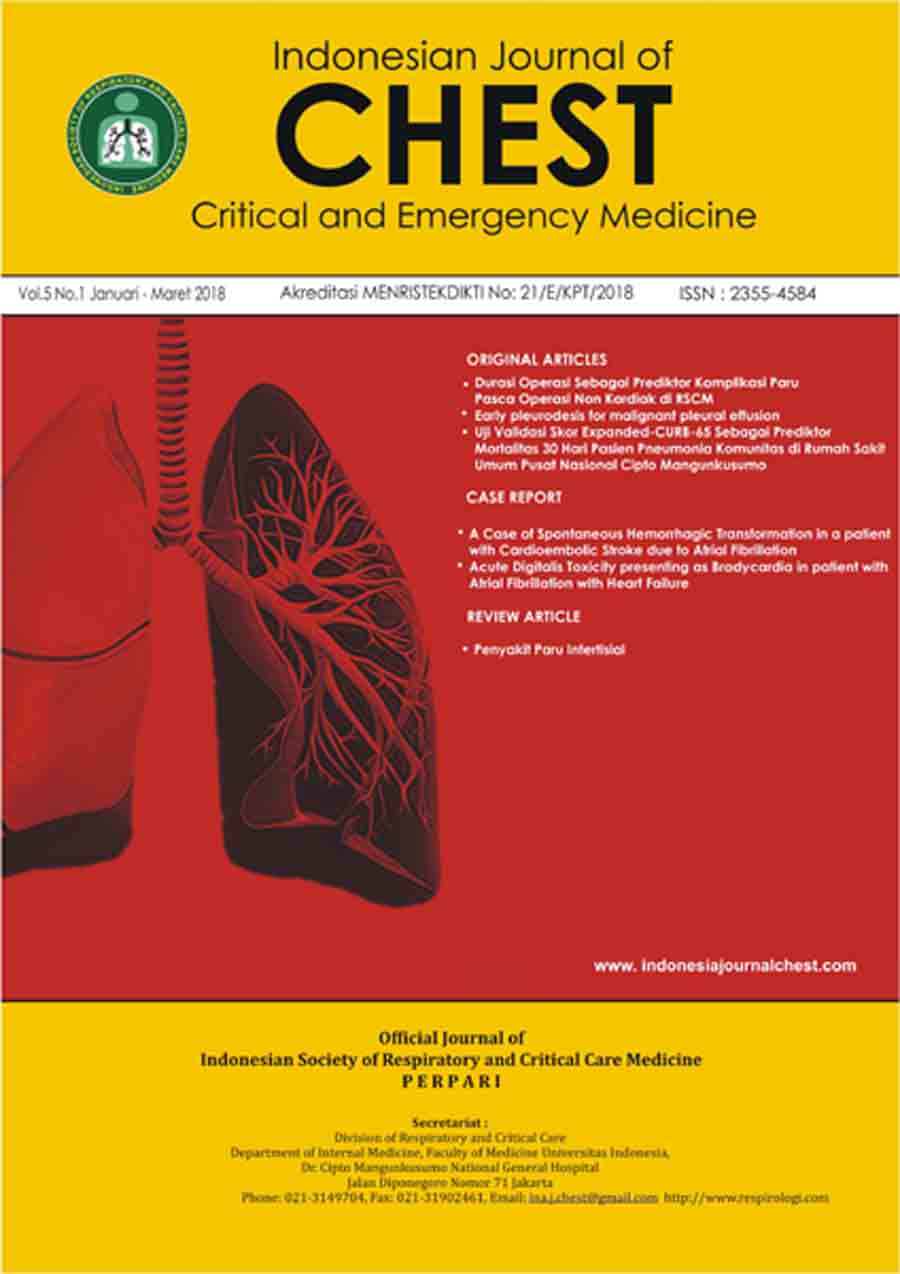 Efektivitas Ivermectin Dalam Menurunkan Risiko Mortalitas Pada Pasien Covid-19 Rawat Inap
Vol 8 No 2 (2021)
Efektivitas Ivermectin Dalam Menurunkan Risiko Mortalitas Pada Pasien Covid-19 Rawat Inap
Vol 8 No 2 (2021)ABSTRAK
Latar belakang: Penyakit virus corona (COVID-19) yang disebabkan Infeksi Severe Acute Respiratory Syndrome Coronavirus 2 (SARS CoV-2) memiliki angka total kematian dunia yang tinggi. Namun, hingga saat ini belum ditemukan terapi definitif yang sesuai untuk penyakit tersebut. Ivermectin memiliki aktivitas antivirus yang diduga dapat mempengaruhi dan menghambat replikasi virus SARS CoV-2. Laporan ini bertujuan mengetahui efektivitas ivermectin dalam menurunkan risiko mortalitas pada pasien rawat inap dengan COVID-19. Metode: Pencarian literatur secara sistematis sesuai dengan pertanyaan klinis dilakukan pada lima database, yaitu PubMed, Embase, Science Direct, Scopus, dan Cochrane. Pemilihan artikel dilakukan berdasarkan kriteria inklusi dan eksklusi. Artikel yang terpilih kemudian ditelaah kritis dan dianalisis lebih lanjut berdasarkan aspek validitas, kepentingan hasil, dan kemamputeraan. Hasil: Berdasarkan hasil pencarian dan seleksi, didapatkan satu artikel Randomized Controlled Trial dan tujuh telaah sistematis dan meta-analisis. Tidak ada artikel yang mencapai kekuatan bukti satu. Kedelapan artikel menunjukan penurunan mortalitas pada kelompok pasien dengan terapi ivermectin, namun hanya tiga artikel yang memberikan nilai yang bermakna secara statistik. Pada semua artikel, manfaat dinilai tidak lebih besar dibandingkan risiko cedera. Kesimpulan: Efektivas ivermectin sebagai terapi tambahan dalam menurunkan mortalitas pada pasien COVID-19 dewasa dengan rawat inap belum terbukti sehingga pengguaannya dalam praktis klinis sehari-hari belum dapat disarankan.
Kata kunci: COVID-19, SARS CoV-2, ivermectin, mortalitas, laporan kasus berbasis bukti -
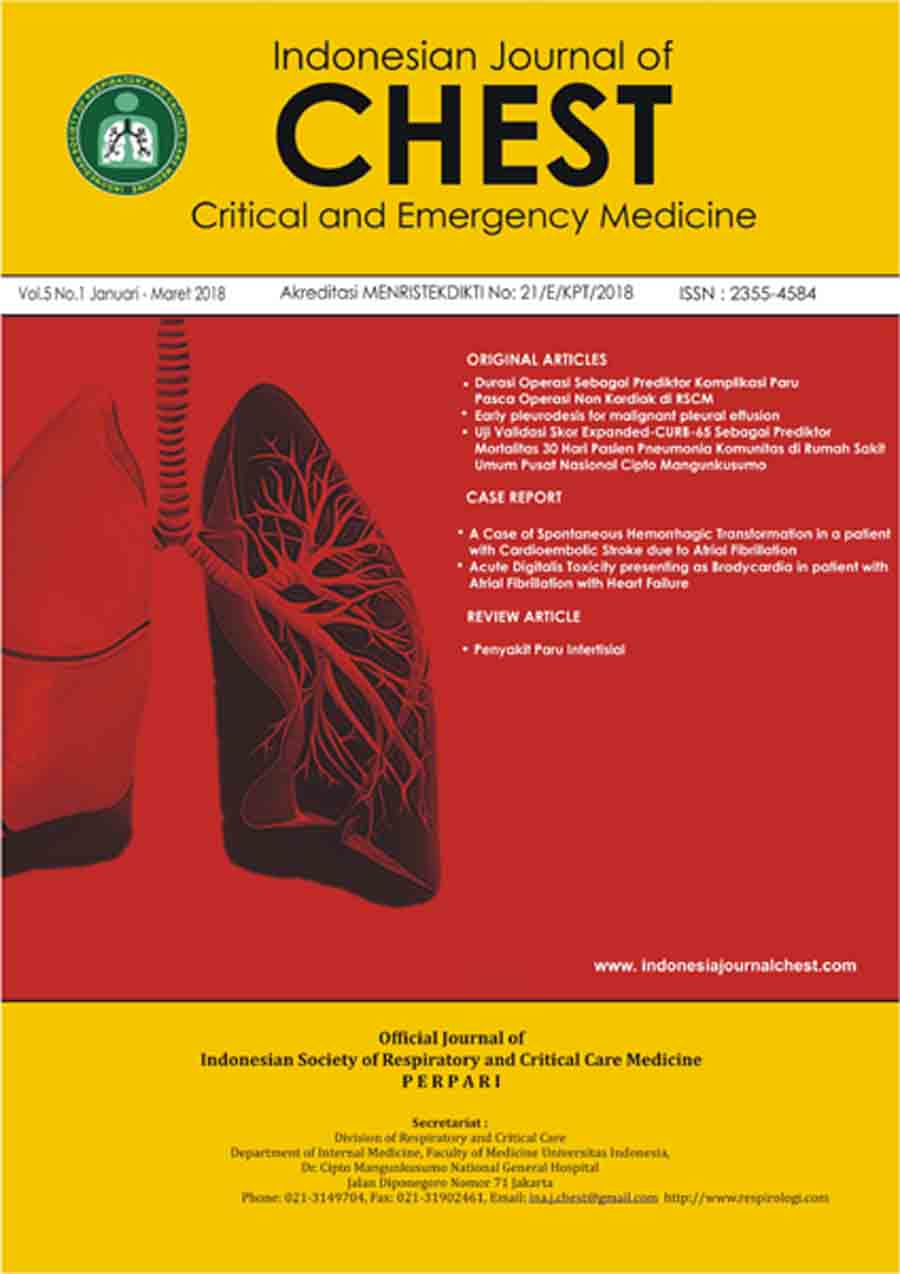 Effectivity of High Dose Vitamin C as Adjuvant Therapy in Hospitalized COVID-19 Patient
Vol 8 No 2 (2021)
Effectivity of High Dose Vitamin C as Adjuvant Therapy in Hospitalized COVID-19 Patient
Vol 8 No 2 (2021)ABSTRACT
Background: COVID-19 is an infectious disease caused by SARS-CoV-2 virus, which has become the main health issue worldwide. COVID-19 has a wide spectrum of clinical manifestations, ranged from asymptomatic to critical disease, which further can lead to death. In the advanced stage, COVID-19 can cause ARDS (Acute Respiratory Distress Syndrome), sepsis shock, and multiorgan failure that increase the hospitalization and mortality rate. Presently, the administration of high dose vitamin C (> 5 gram/day) is being considered as the adjuvant therapy in hospitalized COVID-19 patient. Objective: To explore the effect of high dose vitamin C in hospitalized COVID-19 patients.
M
ethods: Literature searching was done in five different databases (PubMed, Cochrane Library, SpringerLink, Semantic Scholar, and EBSCOhost) with vitamin C?, high dose?, COVID-19?, and outcome? as the keywords.. The subsequent critical appraisal was performed in four relevant studies to assess the validity, importance, and applicability using Oxford Centre for Evidence-Based Medicine checklist. Result: Three studies showed that administration of high dose intravenous vitamin C in hospitalized COVID-19 patient could reduce COVID-19 symptoms, improve laboratory result, and prevent the aggravation of COVID-19 disease, yet its effect in reducing mortality rate was not seen yet. Meanwhile, one study didn?t show any good effect from the administration of high dose oral vitamin C in COVID-19 patient. Conclusion: The administration of high dose intravenous vitamin C can be considered as the adjuvant therapy in hospitalized COVID-19 patients.
Keywords: high dose vitamin C, COVID-19, clinical symptom improvement, laboratory value improvement, mortality rate reduction -
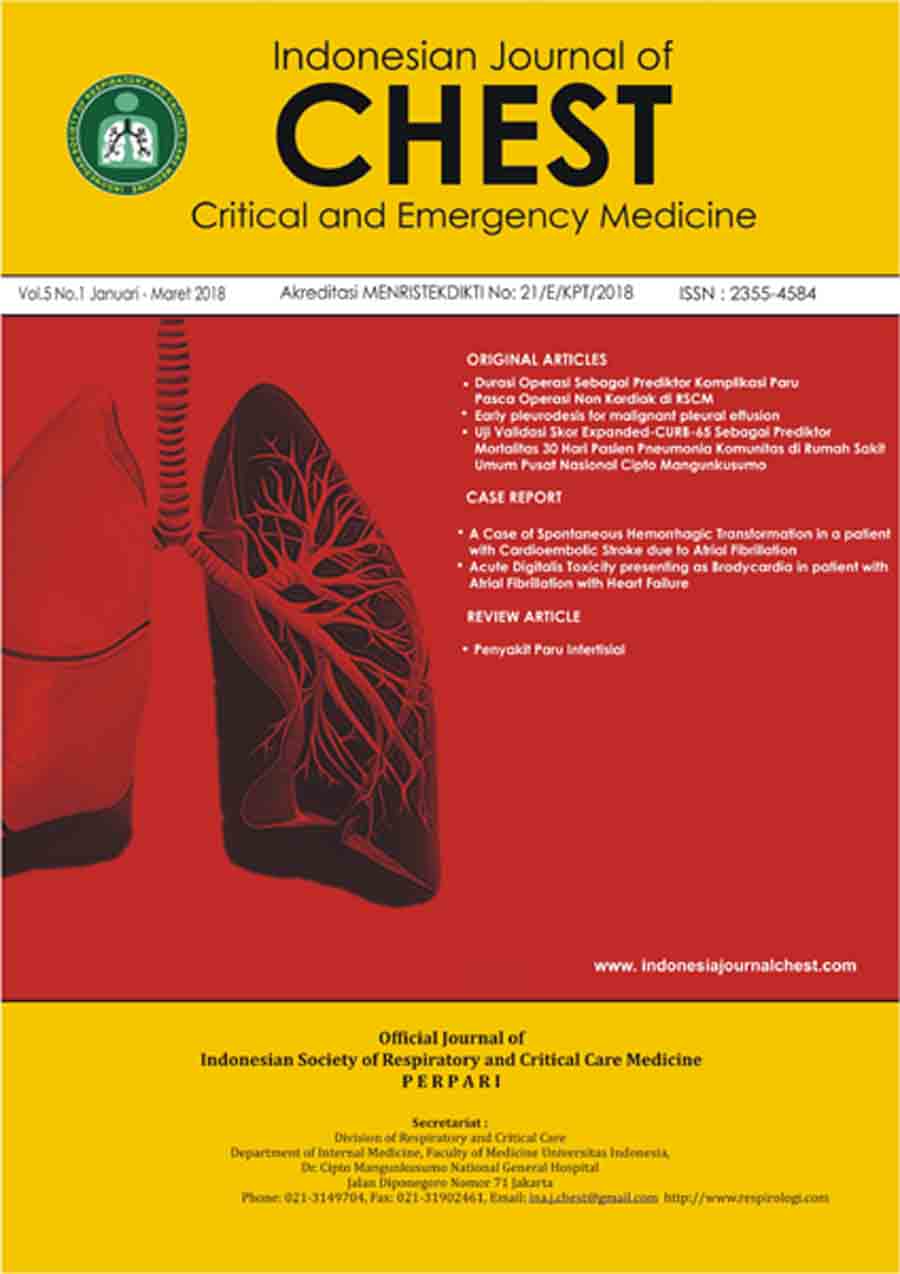 Aplikasi Terapi Oksigen High Flow Nasal Cannule
Vol 8 No 2 (2021)
Aplikasi Terapi Oksigen High Flow Nasal Cannule
Vol 8 No 2 (2021)ABSTRACT
High Flow Nasal Cannule is a high flow oxygen therapy using specific equipment so that it can give high flow oxygen using nasal cannule. High flow nasal cannule can achieve FiO2 100%. High flow nasal cannule reduce airway resistance so that improve ventilation and oxygenation. Application of high flow nasal cannule is high cost and a special training is needed, however its effectivity is proven in several studies. In COVID-19 cases, HFNC is effective and also can improve patients survival. Moreover, HFNC can provide comfort to the patient.
Keywords: oxygen, high flow nasal cannule -
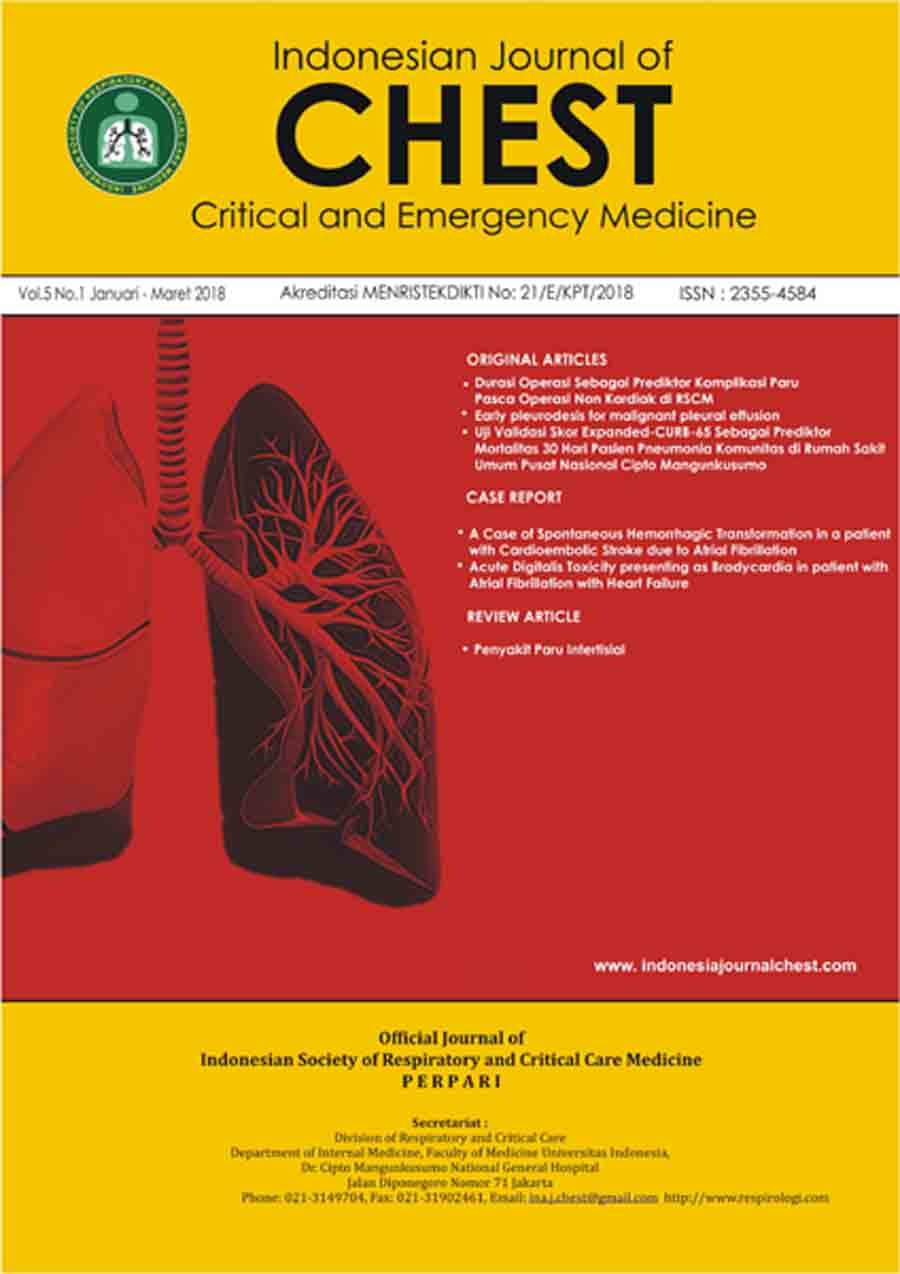 Kesahihan Simplified Acute Physiology Score (SAPS) 3 sebagai Prediktor Mortalitas Pneumonia Komunitas Bakterial dan Viral Berat
Vol 8 No 2 (2021)
Kesahihan Simplified Acute Physiology Score (SAPS) 3 sebagai Prediktor Mortalitas Pneumonia Komunitas Bakterial dan Viral Berat
Vol 8 No 2 (2021)ABSTRACT
Background : Severe community acquired pneumonia (SCAP) is the most commomly encountered critical illness with high short-term mortality rate. Several general prediction models have been validated in predicting the outcome of critical illnesses, but still few evidences for SAPS 3 validation for SCAP. This study aims to evaluate the calibration and discrimination performance of SAPS 3 to predict the in-hospital mortality of SCAP.
M
ethods : We used retrospective cohort design design and collected the medical record of patients admitted with SCAP to emergency ward, high care and intensive care unit of Cipto Mangunkusumo Hospital from March 2019-March 2021). The 30 days in-hospital mortality was documented during the study. Collected data were analyzed using goodness-of-fit Hosmer-Lemeshow tset for the calibration performance and Receiver Operating Curve (ROC) for the discrimination performance of SAPS 3 toward the in-hospital mortality of SCAP.
Results :There were 484 subjects with SCAP with mortality rate of 49,2%. 73,8% was identified to have viral pneumonia due to severe/critical COVID-19 and 25,6% were bacterial. The calibration performance was good (p=0,519, correlation coefficient r=0,993 for the observed and expected from Hosmer-Lemeshow). Discrimination performance was excellent for total score with AUC 0,921 (95%CI 0,898-0,944). Calibration performance was also found to be very good in predicting mortality for general SAPS 3 formula (p=0,054, r=0,984) as well as for Austalasias (p=0,092, r=0,986). The probability of death prediction formula, however, both shows poor graphical goodness of fit for the calibration performance.
Conclusion :The calibration and discrimination performance of SAPS 3 score in predicting the in-hospital mortality of SCAP is good, but not for the general and Australasian formula in predicting mortality.
Keywords: Severe community acquired pneumonia, mortality, SAPS 3 -
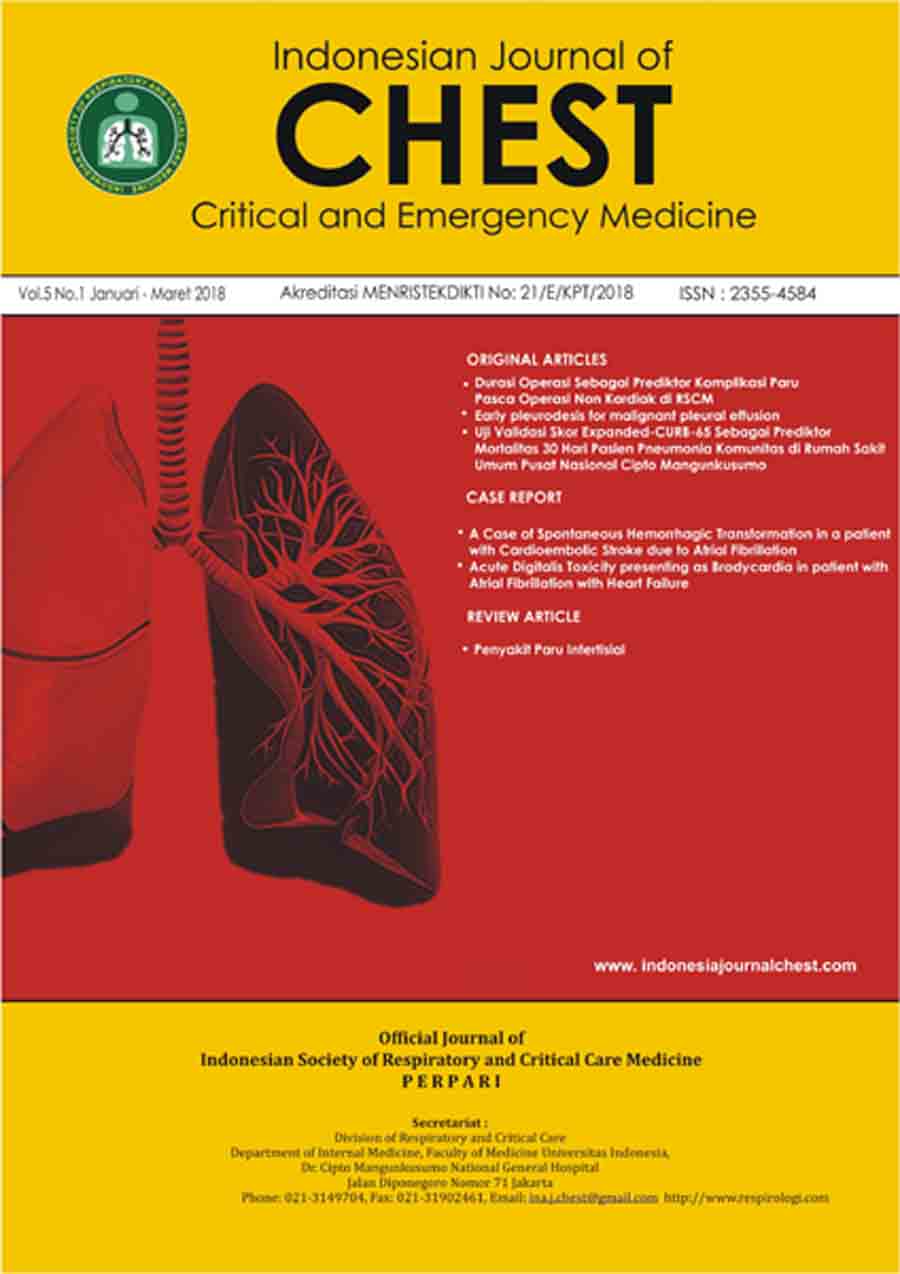 Effect Of Dyspnea On The 1-Year Survival Of Patients With Progressive Disease At Cipto Mangunkusumo Hospital
Vol 8 No 1 (2021)
Effect Of Dyspnea On The 1-Year Survival Of Patients With Progressive Disease At Cipto Mangunkusumo Hospital
Vol 8 No 1 (2021)Giri Satriya1, Gurmeet Singh2, Rudi Putranto3, Hamzah Shatri4
1Departemen Ilmu Penyakit Dalam, Fakultas Kedokteran Universitas Indonesia-RSUPN Cipto Mangunkusumo
2Divisi Respirologi dan Penyakit Kritis, Departemen Ilmu Penyakit Dalam, Fakultas Kedokteran Universitas Indonesia-RSUPN Cipto Mangunkusumo
3Divisi Psikosomatik dan Paliatif, Departemen Ilmu Penyakit Dalam, Fakultas Kedokteran Universitas Indonesia-RSUPN Cipto Mangunkusumo
4Unit Epidemiologi Klinik Departemen Ilmu Penyakit Dalam, Fakultas Kedokteran Universitas Indonesia-
RSUPN Cipto MangunkusumoAbstract
Background: Dispnea as a subjective sensation is a sign of certain underlying disease which need to be diagnosed and treated to prevent the mortality, especially in patients with progressive disease. Previous study has shown that patients with dyspnea at admission have higher mortality.
Objective: To determine the association between dyspnea with 1 year survival in patients with progressive disease who were admitted to RSCM. Methods: A retrospective cohort study was conducted by tracing the medical records of 155 patients with progressive disease who were hospitalized at RSCM during August 2018 until December 2019. Recruited subjects were adults patients who 18 years above diagnosed with COPD, heart failure, malignancy or CVD. Identity, dispnea, and survival data were collected through medical records. Statistical analysis was conducted by using multivariate and Kaplan Meier analysis using SPSS software. Results: In this study, the survival rate of patients with progressive disease who were admitted to RSCM in August 2018-December 2019 was 34.8% with a mean survival of 163 days and a median survival of 72 days. Among the patients 49% had dyspnea. The survival rate of patients with dispnea was 11% with a mean survival of 115 days and a median survival of 29 days. Dyspnea was significantly associated with survival with p < 0,05 and adjusted HR 1.928 (95% CI: 1.225 - 3.03). In the subgroup analysis of heart failure, malignancy, and CVD, dispnea was associated with survival with p<0,05 and the HR value for every group 16,59 (95% CI: 2,20 124,73), 2,18 (95% CI: 1,33 3,58), and 2,90 (95% CI: 1,34 6,28). Conclusion: Dyspnea has significant association with survival.
Key words: dyspnea, progressive disease, survival. -
 Tuberculous pericarditis mimicking Bacterial pericarditis in Pericardial effusion
Vol 8 No 1 (2021)
Tuberculous pericarditis mimicking Bacterial pericarditis in Pericardial effusion
Vol 8 No 1 (2021)Lidyawati Mulyo1, Prayudi Santoso2, Arto Yuwono Soeroto2
1Departement of Internal Medicine
2Divison of Pulmonology and Critical Respiration, Department of Internal Medicine
Faculty of Medicine Universitas Padjadjaran, Dr. Hasan Sadikin Hospital
Jl. Pasteur No.38, BandungAbstract
Tuberculosis (TB) is one of the infectious diseases with the highest prevalence which causes high mortality worldwide. Although rarely found, TB pericarditis can be life threatening because it can cause pericardial effusion which, if left untreated, can cause death due to cardiac tamponade. A 44 years old man presented with cardiac tamponade with clinical appearance of Tb, but pericardial fluid analysis favored bacterial pericarditis. Pericardial fluid analysis showed fluid glucose was 4, fluid protein was 5.320, LDH was 3.781, yellow, cloudy, cell count: 1.716, polymorphonuclear (PMN) 85,2, mononuclear (MN) 14,8. Patient then diagnosed with severe pericardial effusion with sign of tamponade due to bacterial pericarditis with differential diagnosis was tuberculous pericarditis. On the 4th day of treatment, it was found out from the results of GenXpert that there was Mycobacterium tuberculosis in the pericardial fluid with increased Adenosine deaminase (ADA) level, and Chest X-ray showed milliary TB. The patient was then given category 1 anti-tuberculosis drug and methylprednisolone 40 mg. The diagnosis of TB pericarditis is challenging, it requires knowledge about its pathogenesis and thorough analysis in its diagnosis. Not only depending on one tool, but still clinical assessment and confirmation with definite diagnostic tools such as culture or histopathology.
Keywords: bacterial pericarditis, diagnosis, pericardial fluid, PMN, tuberculous pericarditis -
 Blood CD4 And CD8 Count as predictors of 30 Days mortality Insevere Pneumonia patients at the dr. Ciptomangunkusumo national general Hospital Jakarta
Vol 8 No 1 (2021)
Blood CD4 And CD8 Count as predictors of 30 Days mortality Insevere Pneumonia patients at the dr. Ciptomangunkusumo national general Hospital Jakarta
Vol 8 No 1 (2021)Gurmeet Singh,1 Randhy Fazralimanda,2 Alvina Widhani,3 Juferdy Kurniawan4
1. Dept. of Internal Medicine, Division of Respirology and Critical Illness, Faculty of Medicine Universitas Indonesia,
Cipto Mangunkusumo National General Hospital, Jakarta, Indonesia
2. Dept. of Internal Medicine, Faculty of Medicine Universitas Indonesia,
Cipto Mangunkusumo National General Hospital, Jakarta, Indonesia
3. Dept. of Internal Medicine, Division of Allergy and Immunology, Faculty of Medicine Universitas Indonesia,
Cipto Mangunkusumo National General Hospital, Jakarta, Indonesia
4. Dept. of Internal Medicine, Division of Hepatobilliary and Pancreatic Medicine, Faculty of Medicine Universitas Indonesia,
Cipto Mangunkusumo National General Hospital, Jakarta, IndonesiaAbstract
Background: Severe pneumonia is a major health problem in Indonesia and also in the world. The immune system is known to play important role in the pathogenesis of pneumonia, but few studies have assessed the relationship between blood CD4 and CD8 count and mortality from severe pneumonia in negative HIV population.
Methods: This study was a prospective cohort study conducted at Cipto Mangunkusumo General Hospital from June to August 2020. The outputs were 30-days survival rate and optimal cut-off value for blood CD4 and CD8 count to predict 30-days mortality and mortality risk. Data analysis used Kaplan-Meier survival, ROC curves and multivariate Cox regression.
Results: Of the 126 subjects, there was one subject who was lost to follow up. The 30-days mortality rate was 26.4%. The optimal cut-off value for blood CD4 count was 406 cells/?L (AUC 0,651, P=0,01, 95%CI 0,541-0,760, sensitivity 64%, specificity 61%), blood CD8 count was 263 cells/?L (AUC 0,639, P=0,018, 95% CI 0,534-0,744, sensitivity 62%, specificity 58%). CD4 blood count < 406 cells/?L had a crude HR of 2,696 (P=0,008, 95%CI 1.298-5.603), blood CD8 count < 263 cells/?L had a crude HR of 2,133 (P=0,042, 95%CI 1,035-4,392) and adjusted HR of 2,721 (P=0,005, 95%CI 1,343-5,512). If sepsis and pulmonary tuberculosis were added to the blood CD4 and CD8 count, the AUC value was 0,752 (P=0,000, 95%CI 0,662-0,842).
Conclusion: Blood CD4 and CD8 count had poor accuracy in predicting 30-days mortality in patients with severe pneumonia. Groups with lower blood CD4 and CD8 count had a higher risk of 30-days mortality.
Keywords: severe pneumonia, CD4 count, CD8 count, 30 days mortality -
 Characteristics Of Outpatients With Tuberculosis And Human Immunodefi�ciency Virus At Dr. Hasan Sadikin General Hospital Bandung In 2019
Vol 8 No 1 (2021)
Characteristics Of Outpatients With Tuberculosis And Human Immunodefi�ciency Virus At Dr. Hasan Sadikin General Hospital Bandung In 2019
Vol 8 No 1 (2021)Vania Felicia1, Iceu Dimas Kulsum2, Susantina Prodjosoewojo3
1Faculty of Medicine, Universitas Padjadjaran, Bandung
2Division of Pulmonology and Critical Care Medicine, Department of Internal Medicine, Faculty of Medicine, Universitas Padjadjaran/Dr. Hasan Sadikin General Hospital, Bandung
3Department of Internal Medicine, Faculty of Medicine, Universitas Padjadjaran/Dr. Hasan Sadikin General Hospital, BandungAbstract
Background: The burden of tuberculosis (TB) and Human Immunodeficiency Virus (HIV) co-infection is still alarming with high number of cases and mortality especially in West Java. This is affected by delayed treatment in these patients due to difficulty in diagnosis of TB in HIV patients. Clinical presentations were commonly atypical.
Objective: This study aims to identify sociodemographic characteristics, clinical manifestations, and additional findings of outpatients with TB and HIV at Dr. Hasan Sadikin General Hospital Bandung in 2019.
Methods: A retrospective descriptive-observational study on medical records of outpatients in Directly Observed Treatment Short-course (DOTS) and HIV units of Dr. Hasan Sadikin General Hospital Bandung was conducted at 1 January-31 December 2019. Results: There were 22 outpatients with the diagnosis of TB with first category of treatment and HIV, mean age of 34,91 7,68 years, 9,87 19,07 months since HIV diagnosis, BMI of 17,9 2,95. Majority were male (86,4%), married (55%), working (70,6%), in high school (88,2%). Chronic cough (18,6%) was commonly found. There were equal number of patients with positive and negative AFB sputum smear. Most were pulmonary TB (53.3%), Rifampicin sensitive (25%), CD4 cell count of <200 cells/mm3 (77,3%) and stage IV of HIV (72,7%). Most patients had available chest x-ray results (85%), with pulmonary TB (60%) and unilateral infiltrate (40%).
Conclusion: Most of the patients were male in productive age with low BMI, stage IV HIV with low CD4 cell count. Most patients were found with common cough, diagnosed as pulmonary TB, with chest x-ray results showed pulmonary TB with unilateral infiltrate. There were equal number of positive and negative results on AFB sputum smear and most were rifampicin sensitive.
Keywords: tuberculosis, HIV, characteristics -
 Pengaruh Diabetes Melitus Terhadap Konversi Kultur Sputum Dini Pada Pasien Tuberkulosis Resistan Obat Ganda
Vol 8 No 1 (2021)
Pengaruh Diabetes Melitus Terhadap Konversi Kultur Sputum Dini Pada Pasien Tuberkulosis Resistan Obat Ganda
Vol 8 No 1 (2021)Zen Ahmad1, Alwi Shahab1, Mohamad Zacky Amirullah1, Erial Bahar1
1Departemen Ilmu Kesehatan Penyakit Dalam, Fakultas Kedokteran, Universitas Sriwijaya, PalembangAbstract
Background: Multidrug-resistant tuberculosis (MDR TB) is a form of tuberculosis infection caused by mycobacterium strains that are resistant to at least two of the main first-line drugs, i.e. isoniazid and rifampicin. In general, MDR TB treatment success rate in Indonesia is only 47%. One of the factors that may influence the treatment outcomes is Diabetes Mellitus (DM). Early sputum culture conversion was associated with better treatment outcomes compared to late sputum culture conversion. Late sputum culture conversion is associated with poor outcomes and increased mortality rate (50%-80%).
Objective: This study aimed to assess the effects of DM on early sputum culture conversion among MDR TB patient who received short-term regimen therapy.
Methods: This was a retrospective cohort observational analytical study conducted at Borang MDR TB of Mohammad Hoesin General Hospital Palembang from April 2019 to January 2020.
Results: A total of 91 participants were included in the study with DM prevalence of 27%. Early sputum culture conversion was found in 11 subjects with DM (44%) and in 45 non-DM subjects (68%). Analysis results showed that MDR TB patient with DM has 2,7 times of having late sputum culture conversion (RR 2,7; 95% CI, 1,061 7,013, p= 0.037) compared to non-DM counterpart. Conclusion: Diabetes Mellitus affects sputum culture conversion among MDR TB patients receiving short-term regimen therapy at Mohammad Hoesin General Hospital Palembang.
Keywords: multidrug-resistant tuberculosis, diabetes mellitus, sputum culture conversion. -
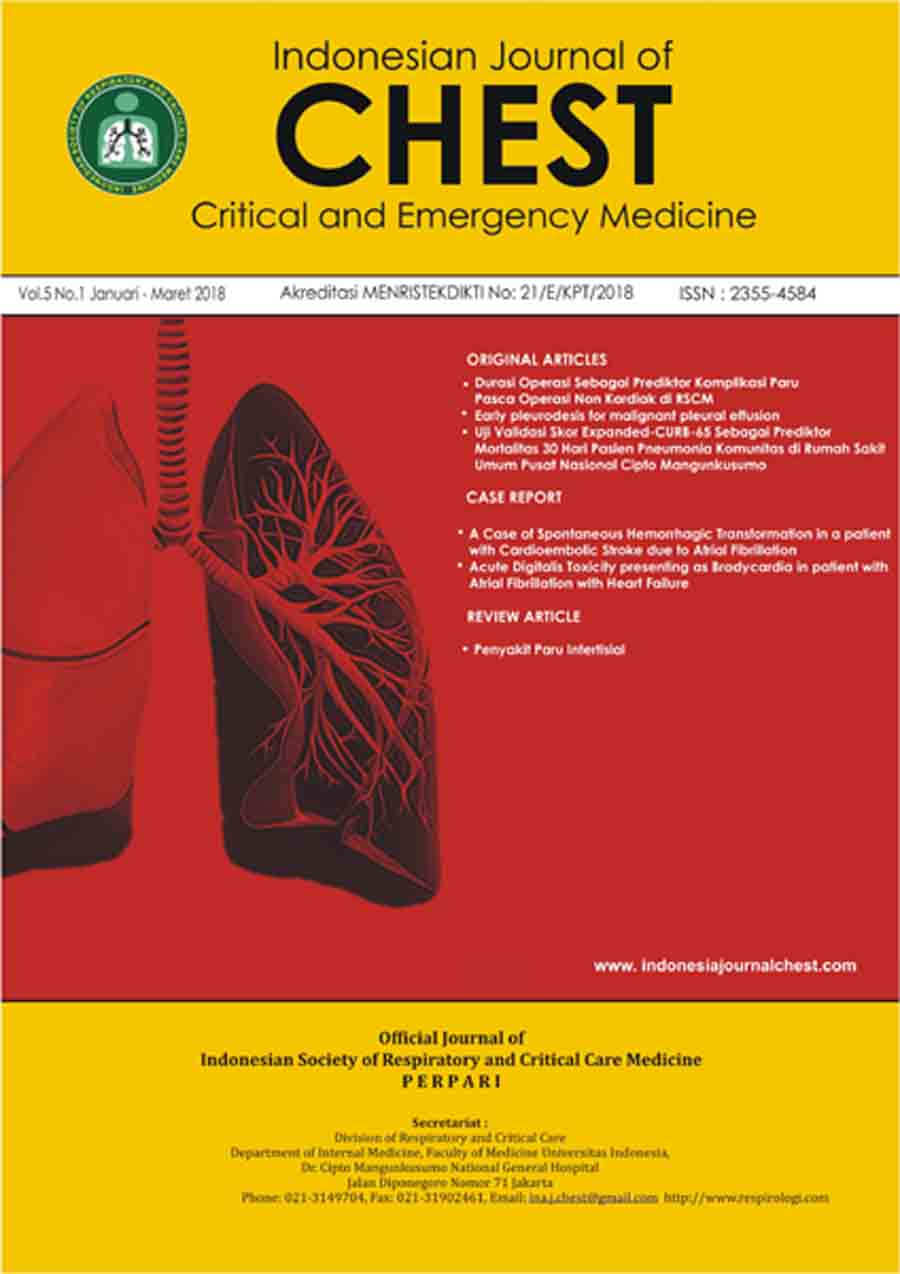 MODALITAS PEMERIKSAAN PENUNJANG PADA PENEGAKAN DIAGNOSTIK PNEUMOCYTIS PNEUMONIA (PCP) PADA HIV/AIDS
Vol 8 No 1 (2021)
MODALITAS PEMERIKSAAN PENUNJANG PADA PENEGAKAN DIAGNOSTIK PNEUMOCYTIS PNEUMONIA (PCP) PADA HIV/AIDS
Vol 8 No 1 (2021)Anita Nur Charisma1,2*, Kristin Purnama Dewi1,2, Erika Marfiani1,3
1Fakultas Kedokteran, Universitas Airlangga, Surabaya
2Departemen Pulmonologi dan Ilmu Kedokteran Respirasi, Rumah Sakit Dr. Soetomo, Surabaya
3Departemen Ilmu Penyakit Dalam, Rumah Sakit Dr. Soetomo, SurabayaAbstract
Pneumocystis jirovecii pneumonia (PCP) is an opportunistic fungal infection in respiratory system caused by fungal organisms that cause pneumonia. The incidence of PCP is relatively low. Appropriate investigations are needed to establish diagnostics for suspected PCP infection in HIV / AIDS patients. Detection of PCP cases should be done as early as possible, so that prophylaxis and PCP treatment are not delayed and can reduce mortality.
Keywords: Investigation diagnostics, pneumocystis pneumonia, HIV/AIDS -
 EFEK PEMBERIAN TERAPI VITAMIN D TERHADAP PERBURUKAN PASIEN RAWAT INAP COVID-19
Vol 8 No 1 (2021)
EFEK PEMBERIAN TERAPI VITAMIN D TERHADAP PERBURUKAN PASIEN RAWAT INAP COVID-19
Vol 8 No 1 (2021)Arfian Muzaki1, Gurmeet Singh2
1Program Studi Profesi Dokter, Fakultas Kedokteran Universitas Indonesia
2Divisi Respirologi dan Penyakit Kritis, Dept. Ilmu Penyakit Dalam,RSUPN Cipto Mangunkusumo,
Fakultas Kedokteran Universitas IndonesiaAbstract
Background: Corona virus disease 2019 (COVID-19) is a new disease caused by the SARS-CoV2 virus and announced to be a global pandemic. Symptoms can vary in different people and are divided into asymptomatic, mild, moderate, and severe. Vitamin D is said to have an effect on lowering the risk of microbial infection and death. Therefore, vitamin D is given to COVID-19 patients with the hope of reducing clinical deterioration and mortality.
Objective: To assess the effect of vitamin D on clinical deterioration and mortality in COVID-19 patients based on studies that have been conducted.
Methods: Searching randomized controlled trials and cohorts in three databases, namely PubMed, Scopus, and Cochrane. Articles will be selected and then subjected to a critical review using guidelines from the University of Oxfords Center for Evidence-based Medicine (CEBM).
Results: A total of three studies were selected with one randomized controlled trial and two cohort studies. All studies claim that offering vitamin D therapy decreased the incidence of admission of patients to the ICU (invasive mechanical ventilation) and mortality. Study drawbacks may bias and influence the significance of the association between vitamin D administration and clinical deterioration.
Conclusion: Administration of vitamin D in hospitalized COVID-19 patients to reduce clinical worsening of patients.
Keywords: Adult, COVID-19, Vitamin D, cholecalciferol, calcifediol -
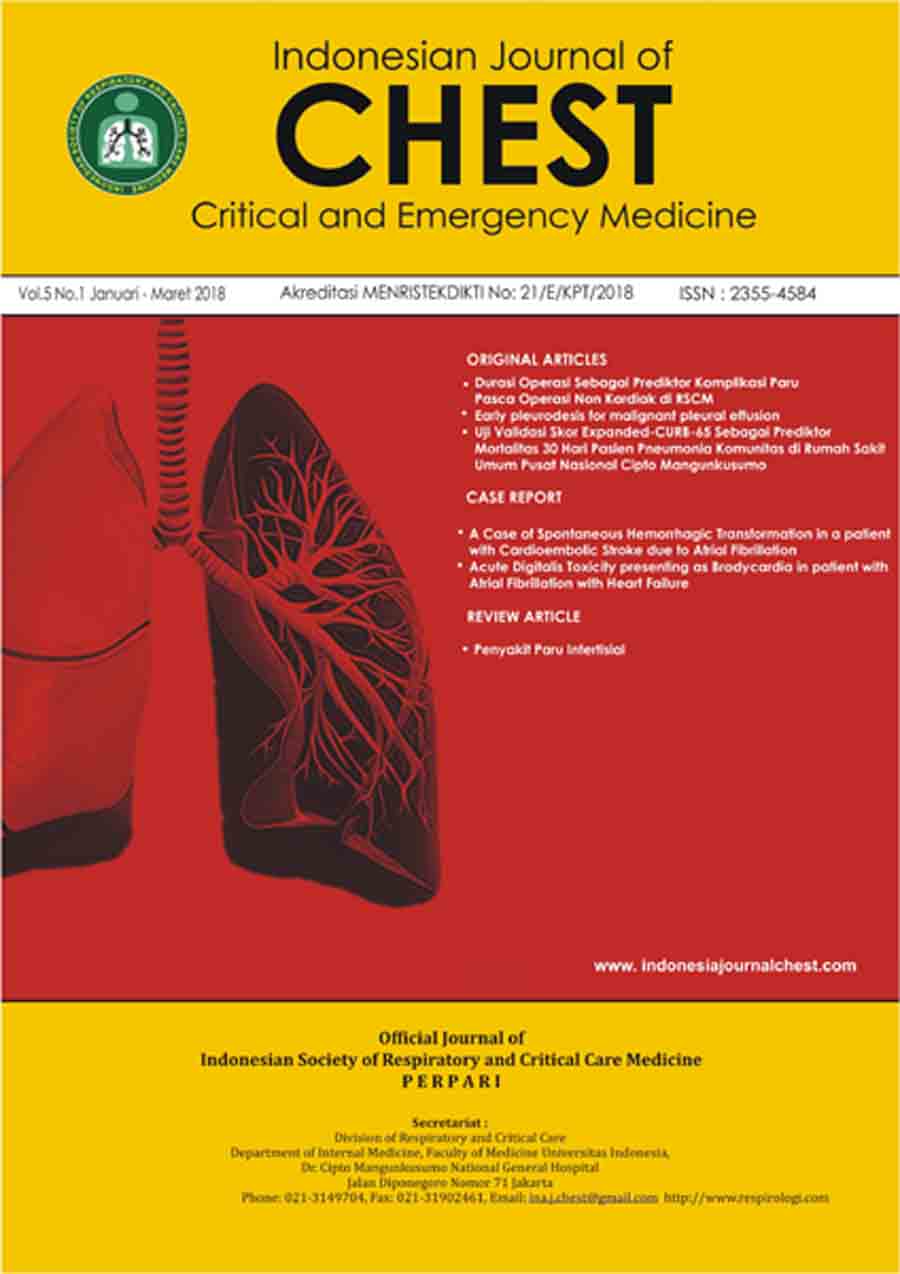 Hospital-Acquired Coronavirus Disease 2019 (Covid-19) In The Beginning Of Epidemic In Indonesia
Vol 7 No 2 (2020)
Hospital-Acquired Coronavirus Disease 2019 (Covid-19) In The Beginning Of Epidemic In Indonesia
Vol 7 No 2 (2020)I Putu Eka Krisnha Wijaya, Ceva Wicaksono Pitoyo, Anindita Kartika Wiraputri,
Michael Aaron Romulo Division of Respirology and Critical Care Internal Medicine, Department of Internal Medicine, Dr. Cipto Mangunkusumo National General Hospital - Faculty of Medicine University of Indonesia
ABSTRACT
Coronavirus disease 2019 (COVID-19) is a novel acute respiratory disease that has been declared as a pandemic by World Health Organization (WHO) since March 11th 2020. General clinical manifestations of COVID-19 are fever, dry cough, and fatigue. Nonetheless, the majority of COVID-19 cases are asymptomatic. In Indonesia, COVID-19 was reported for the first time on March 2nd 2020. However, in the mid of March 2020 our hospital discovered 2 patients with COVID-19 sign and symptoms that were presented after being cared for several days, even though at that time our hospital hadnt had any cases yet. Those patients were checked and all of them were positive for COVID-19. The objective of this case report is to raise the awareness of hospital-acquired COVID-19 infection possibility especially in the region with minimal cases so that healthcare staffs always be vigilant and dont let their guard down towards COVID-19 dissemination threat which is still going on.
Keywords: respiratory medicine, internal medicine
ABSTRAK
Coronavirus disease 2019 (COVID-19) merupakan sebuah penyakit pernapasan akut baru yang dinyatakan sebagai sebuah pandemi oleh World Health Organization (WHO) pada tanggal 11 Maret 2020. COVID-19 memiliki manifestasi klinis umum berupa demam, batuk kering, dan lemas, namun sebagian besar kasus COVID-19 bersifat asimptomatik. COVID-19 pertama kali dilaporkan di Indonesia pada tanggal 2 Maret 2020. Akan tetapi, pada pertengahan bulan Maret 2020 di rumah sakit kami terdapat 2 pasien dengan tanda dan gejala COVID-19 yang muncul setelah beberapa hari dirawat di rumah sakit, meskipun pada saat itu rumah sakit kami belum memiliki kasus. Kedua pasien akhirnya diperiksa dan keduanya didapatkan positif COVID-19. Tujuan laporan kasus ini adalah untuk meningkatkan kewaspadaan terhadap kemungkinan terjadinya infeksi nosokomial terutama pada daerah dengan jumlah kasus yang masih minimal agar tenaga medis tidak lengah dalam menghadapi ancaman penyebaran COVID-19 yang masih akan terus berlanjut.
Kata kunci: respiratory medicine, ilmu penyakit dalam. -
 Manifestasi Ekstra Paru Coronavirus Disease 2019
Vol 8 No 1 (2021)
Manifestasi Ekstra Paru Coronavirus Disease 2019
Vol 8 No 1 (2021)Telly Kamelia
Division of Respirology and Critical Care Internal Medicine, Department of Internal Medicine, Dr. Cipto Mangunkusumo National General Hospital - Faculty of Medicine University of IndonesiaAbstract
Nowadays, pandemic of COVID-19 impacts worldwide. Coronavirus Disease 2019 affect respiratory system dominantly. However, this virus can also affect other organ systems besides lungs, such as skin, eyes, and heart. This review article was aimed to describe the manifestation of Coronavirus Disease in another organ besides lungs.
Key words: manifestation, extra pulmonary, Coronavirus Disease 2019 -
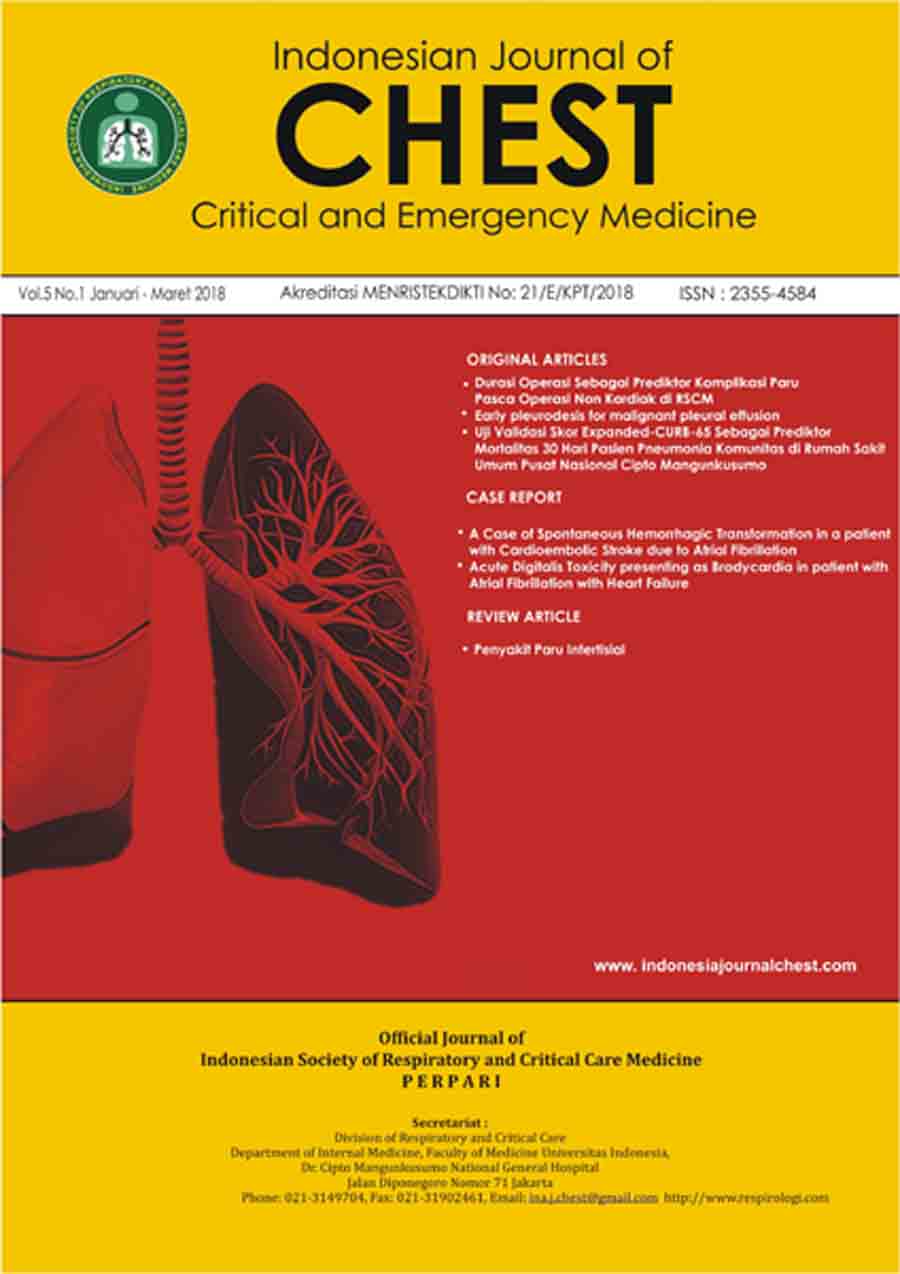 Diagnosis Banding Ground Glass Opacities Pada CT-Scan Toraks Di Era Covid 19
Vol 8 No 1 (2021)
Diagnosis Banding Ground Glass Opacities Pada CT-Scan Toraks Di Era Covid 19
Vol 8 No 1 (2021)ABSTRAK
Ground glass opacities (GGO) merupakan suatu gambaran radiologis non spesifik pada CT-scan toraks dengan berbagai macam etiologi, mulai dari inflamasi, infeksi, edema paru, perdarahan, penyakit interstisial paru hingga keganasan. Saat ini diketahui bahwa GGO juga dapat terdeteksi pada CT-scan toraks pasien-pasien dengan COVID 19. Temuan CT-scan toraks tipikal infeksi pneumonia COVID-19 berupa GGO yang dominan bilateral, lobus bawah dan perifer. Seringkali kemunculan gambaran GGO pada CT-scan toraks dikorelasikan dengan adanya infeksi COVID-19, padahal GGO bisa disebabkan oleh berbagai macam penyakit. Selain itu, probabilitas bahwa gambaran CT-scan toraks menunjukkan COVID-19, sangat tergantung pada probabilitas pra-tes infeksi, yang akhirnya ditentukan oleh prevalensi infeksi komunitas. Oleh, karena beragamnya diagnosis banding GGO, perlu pemahaman mengenai etiopatogenesis, penilaian morfologi dan, distribusi GGO. Meskipun diagnosis pasti tidak bisa dibuat hanya berdasarkan pencitraan saja (CT-scan toraks), kombinasi klinis dan pencitraan secara substansial meningkatkan akurasi diagnosis.
Kata kunci: Ground glass opacities, CT-scan toraks, COVID-19
ABSTRACT
Ground glass opacities (GGO) are non-specific radiological features in the lung parenchyma on chest CT with various etiologies, ranging from inflammation, infection, pulmonary edema, pulmonary hemorrhage, interstitial lung diseases to malignancy. It is currently known that GGO can also be detected on chest CT of patients with COVID 19. Imaging finding in COVID-19 pneumonia are predominantly bilateral, basal and peripheral GGO. Ground glass opacities on chest CT are correlated with the presence of COVID-19 infection, even though GGO can be caused by various diseases. In addition, the probability that the chest CT shows COVID-19, highly depends on the pre-test probability of infection, which is ultimately determined by the prevalence of community infection. Because GGO have wide and varied differential diagnoses, it is necessary to understand the etiopathogenesis, morphological criteria, and distribution of GGO. Although a definite diagnosis cannot be determined by imaging alone (chest CT), the combination of clinical and imaging substantially increases the accurate diagnosis.
Key words: Ground glass opacities, chest CT, COVID-19
-
 DRESS (Drug rash with eosinophilia and systemic symptoms) syndrome In Patient with Anti Tuberculosis Drugs
Vol 7 No 2 (2020)
DRESS (Drug rash with eosinophilia and systemic symptoms) syndrome In Patient with Anti Tuberculosis Drugs
Vol 7 No 2 (2020)Amila Hanifan1, Prayudi Santoso2, ArtoYuwono Soeroto2, Miranti Pangastuti3
1Departement of Internal Medicine
2Divison of Pulmonology and Critical Respiration, Department of Internal Medicine
3Dvision of Dermato-Immunoallergology, Department of Dermatovenerology
Faculty of Medicine Universitas Padjadjaran, Dr. Hasan Sadikin HospitalABSTRACT
Introduction
Drug reaction with eosinophilia and systemic symptoms (DRESS) syndrome is a type of life-threatening drug reaction. Clinical manifestations are morbilli form skin lesions, accompanied by fever, eosifnophilia and systemic involvement which can cause multi-organ failure. The incidence of DRESS syndrome is among 1: 1000 to 1: 10,000 patients, with 10% of mortality rate. Current literature shows that DRESS syndrome can be caused by anti-tuberculosis drugs, including ethambutol (53.5%), rifampicin (26.7%), pyrazinamide (20%), streptomycin (13.3%), and isoniazid (6.7%).
Case Report
A 42-year- old man has been known to suffer from pulmonary TB and undergo anti-tuberculosis drug therapy category I for 3 weeks. The patient has been known to have a history of allergy to ceftriaxone and ibuprofen drugs in previous treatments. The patient underwent a second treatment in the hospital with generalized erythema and scaly itchy skin. The physical examination showed that the patient had 39.1OC of body temperature with icteric sclera. The laboratory examination showed that the eosinophil was increased from 13% to 27%, accompanied by leukocyte 14,400 / UL, haemoglobin10 g / dL, and platelets 86,000 / UL. The examination on kidney and liver function resulted 57.0 mg / dl ureum and creatinine 2.39 mg / dl, and AST 458 IU / l, ALT 155 IU / l, total bilirubin 2,281 mg.dl, ?-glutamyltransferase 134 IU / l, ALP 357 IU / l, INR 1.79. At the beginning of the treatment, the scaly skin of the patient resembled the appearance of xerosis cutis. The development of the treatment showed that the patient fulfilled the DRESS syndrome diagnosis criteria based on RegiSCAR. The patient was treated in an intensive isolation room, and the anti-tuberculosis drugs discontinued.
Conclusion
DRESS syndrome is a drug reaction that can cause death. Diverse skin lesions and hypersensitivity reaction at slow onset make diagnosis difficult to establish. Therefore, diagnosing with RegiSCAR in the beginning and stopping the drug are important in the management of DRESS syndrome.
Keywords: drug eruption, DRESS syndrome, anti-tuberculosis drugs, RegiSCAR, pulmonary TB -
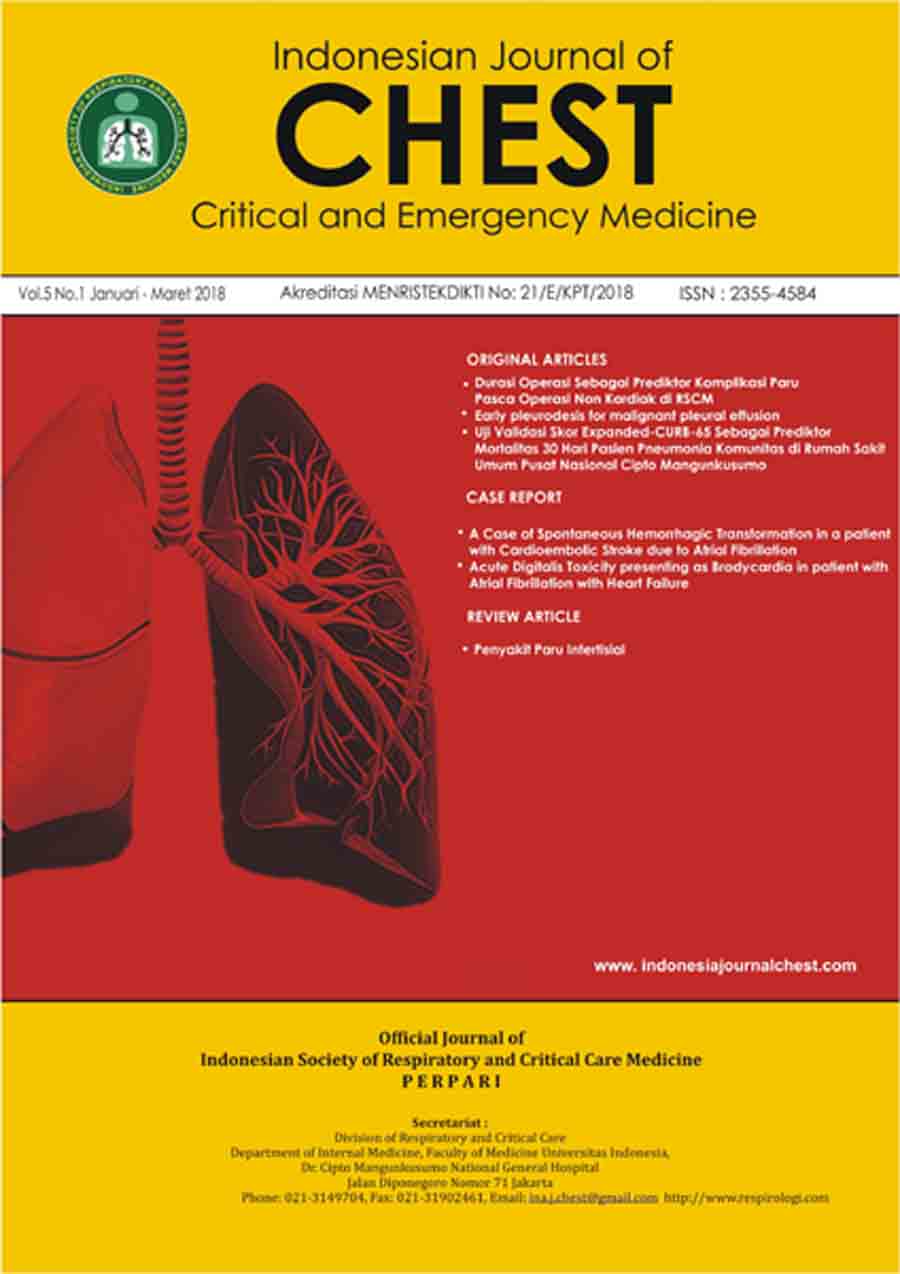 Bilateral Chylothoraks, Chyloperitoneum, Lympedema Lower Extremity In Follicular Lymphoma, Asthma Attack
Vol 7 No 2 (2020)
Bilateral Chylothoraks, Chyloperitoneum, Lympedema Lower Extremity In Follicular Lymphoma, Asthma Attack
Vol 7 No 2 (2020)Fifi Yuniarti, Linda Andriani, Zen Ahmad
Pulmonology Subdivision, Internal Medicine Departement, Medical Faculty SriwijayaUnversity/
Mohammad Hoesin General Hospital, Palembang, IndonesiaABSTRACT
Introduction
Chylothoraksand chyloperitoneum are rare condition characterized by milky appearing fluid with elevated trigliseride. Lymphoma is found in 70%as etiology.
Case Ilustration
A women came to emergency room with chief complain shortness of breath since 4 days before admission. In physical examination found tachypnoe, tachycardia, decreased of vesicular in left side hemithorax, with wheezing in the hemithoraxdextra, dull in abdominal percussion and swelling in bilateral lower extremity. Chest radiology found a pleural effusion in bilateral thorax cavity. From CT abdominal and abdominal ultrasonography we found enlargement of paaraortalympnode, intraabdminalextraluminal mass.
Discussion
Chylothorax and chyloperitoneum diagnosed based onpleural trigliserid levels1100 mg/dL, 1290 mg/dL and 1030 in the peritoneal fluid.From sitology and immunohistochemistry showed a follicular lymphoma.We have done chest tube, pleurodesis with bleomycin, inhalation therapy and chemotherapy. Now she have finished the sixth series of chemetherapy and she have partial response.
Conclusion
We thought chylothorax in this patient caused by follicular lymphoma. Chemotherapy was given as underlying treatment.
Keywords: chylothorax, chyloperitoneum, follicular lymphoma
ABSTRACT
Introduksi
Chylothoraks dan chyloperitoneum merupakan kondisi yang jarang ditemukan yang ditandai dengan adanya cairan putih seperti susu dengan peningkatan kadar trigliserida. Lymphoma ditemkan sebagai etiologi sekitar 70%.
IlustrasiKasus
Seroang perempuan datang keruang emergensi RS Muhammad Hoesin Palembang dengan keluhan utama sesak sejak 4 hari sebelum masuk rumah sakit. Dari pemeriksaan fisikditemukan takipnoe, takikardia, penurunan vesikuler pada hemithoraks kiri disertai wheezing, redup pada saat perkusi abdomen dan edema pada bilateral ektremitas inferior. Dari foto thoraks didapatkan efusi pleura kiri. Dari pemeriksaan CT Scan dan USG abdomen didapatkan adanya pembesaran kelerjar getah bening paraaorta dan massa intraabdomen extraluminal.
Diskusi
Chylothorax dan chyloperitoneumdidiagnosis berdasarkankan dengan trigliserida pada cairan pleura kiri 1100 mg/dL, cairan pleura kanan 1290 mg/dL dan cairan ascites 1030 mg/dL. Dari pemeriksaan sitology serta imunohistokimia dengan kesan limfoma folikuler. Kami lakukan pemsangan chest tube, pleurodesis dengan bleomisin, terapi inhalasi dan kemoterapi. Pasien sudah menyelesaikan 6 seri kemoterapi dan memiliki respon remisi parsial untuk penyakitnya ini.
Kesimpulan
Kami berpikir penyebab chylothoraks pada pasien ini adalah follicular lymphoma. Kemoterapi diberikan sebagai terapi definitive.
Kata kunci: chylothorax, chyloperitoneum, follicular lymphoma -
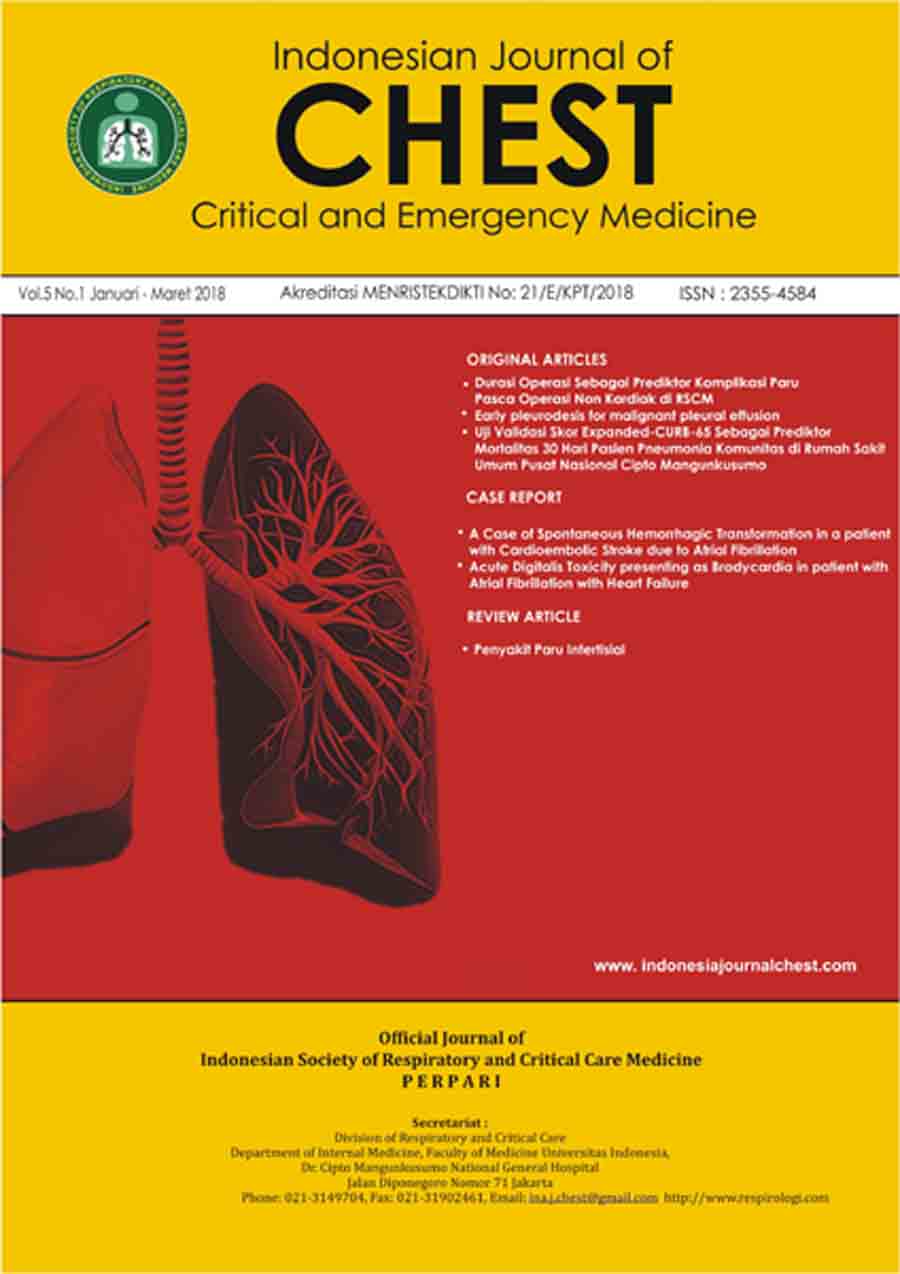 Hipoalbuminemia Pada Pasien Sakit Kritis
Vol 7 No 2 (2020)
Hipoalbuminemia Pada Pasien Sakit Kritis
Vol 7 No 2 (2020)Ceva Wicaksono Pitoyo, Ardeno Kristianto
Divisi Respirologi dan Penyakit Kritis Departemen Ilmu Penyakit Dalam
FKUI RSCM
ABSTRAK
Hipoalbuminemia pada keadaan sakit kritis merupakan penanda mortalitas yang penting. Patofisiologi terjadinya hipoalbuminemia pada pasien sakit kritis memiliki beberapa penyebab, meliputi penurunan produksi, adanya mediator peradangan, kebocoran vascular, serta malnutrisi. Pemberian albumin manusia intravena perlu dipertimbangkan diberikan untuk hypoalbuminemia pada sakit kritis
Kata kunci: Hipoalbuminemia, sakit kritis
ABSTRACT
Hypoalbuminemia in critical illness is an important marker of mortality. The pathophysiology of hypoalbuminemia in critical illness including decrease of production, inflammation marker, vascular leakage, and malnutrition. Administration of intravenous human albumin is needed to be considered for treatment of hypoalbuminemia in critical illness.
Keywords: hypoalbuminemia, critical illness -
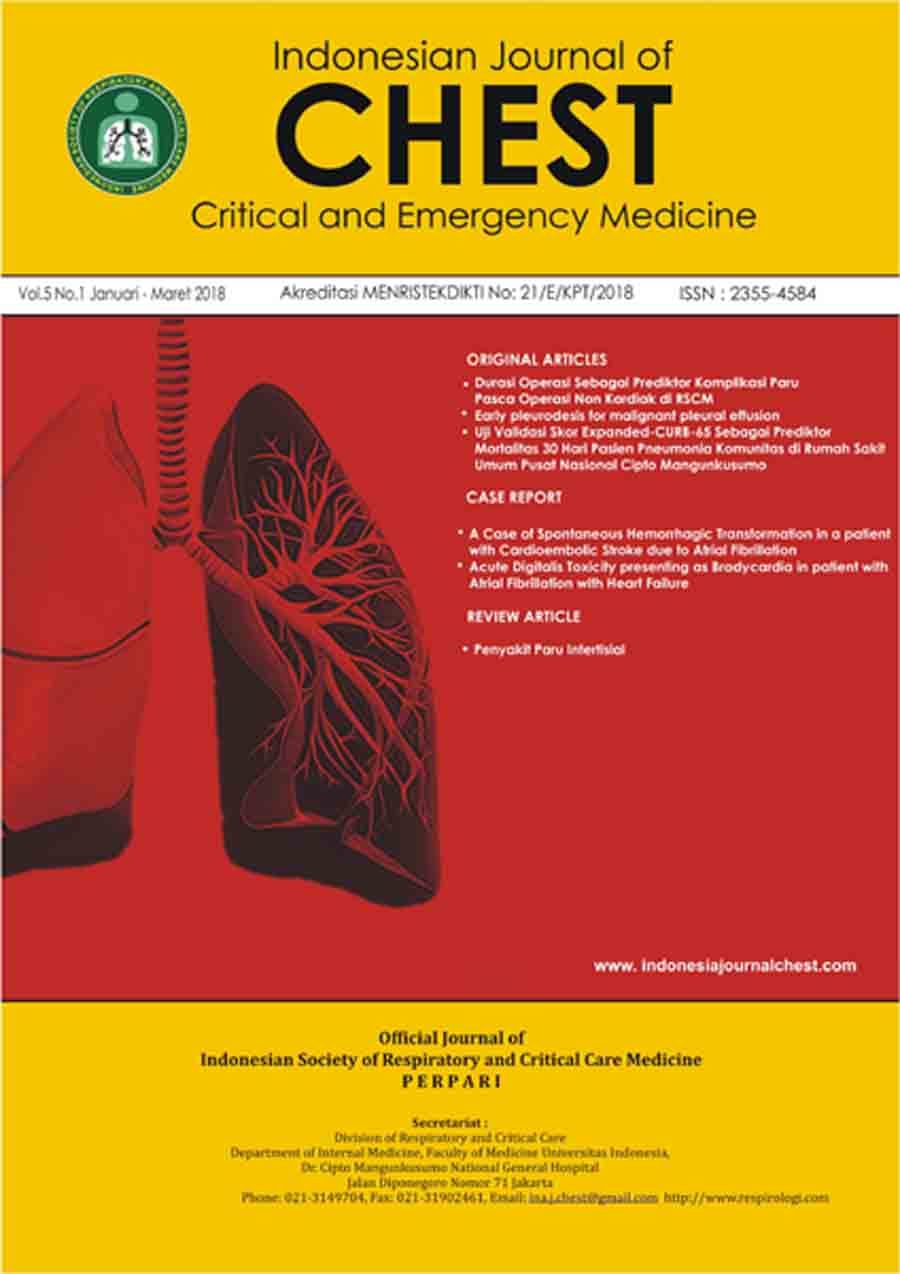 Mekanisme Hepatotoksisitas Dan Tatalaksana Tuberkulosis Pada Gangguan Hati
Vol 7 No 2 (2020)
Mekanisme Hepatotoksisitas Dan Tatalaksana Tuberkulosis Pada Gangguan Hati
Vol 7 No 2 (2020)Ivan Banjuradja*, Gurmeet Singh**
Abstrak Abnormalitas fungsi hati merupakan efek samping tersering pemberian regimen obat anti tuberkulosis (OAT) standar dimana menyebabkan 11% penghentian pemberian OAT pada pasien tuberkulosis (TB). Hepatotoksisitas terutama berhubungan dengan pemberian isoniazid (INH), rifampisin (RIF) dan pirazinamid (PZA) pada golongan OAT lini pertama. Manifestasi hepatotoksisitas bervariasi antara hanya berupa abnormalitas fungsi hati sampai kejadian gagal hati akut. Adapun pedoman tatalaksana TB dengan cedera hati akibat OAT sebagian besar masih didasarkan pada opini ahli. Dalam tinjauan pustaka ini akan dibahas mengenai mekanisme kelainan hati akibat OAT, tatalaksana penghentian, mekanisme reintroduksi OAT pada pasien-pasien yang mengalami kelainan fungsi hati, dan tatalaksana pengobatan pada pasien TB dengan riwayat gangguan fungsi hati sebelumnya.
Kata kunci: obat anti tuberkulosis, hepatotoksisitas
Abstract The abnormalities of liver function are the most common antitubercular side effect, which resulted in 11% drug discontinuation. Hepatotoxicity was mainly associated with the isoniazid (INH), rifampicin (RIF), and pyrazinamide (PZA) administration. The manifestation of hepatotoxicity was greatly varies, from asymptomatic abnormal liver function test to disastrous acute liver failure. Most of the recommendation for the management of liver injury related to antitubercular are based on expert opinion. This literature review will discuss the mechanism of antitubercular inducing liver injury, diagnostic work up, reintroduction of antitubercular, and management of tuberculosis in patients with previous liver dysfunction history.
Keywords: antitubercular, hepatotoxicity



